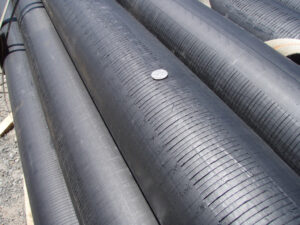
A 1000-gallon trichloroethylene (TCE) spill created an 800-foot long, narrow plume in saprolite and weathered bedrock that embodies the classic heterogeneity challenges to in situ remediation. Gravity drove the dense, non-aqueous liquid (DNAPL) 120 feet downward at varying rates, producing a vertical concentration profile that varies by orders of magnitude within short distances. The project team selected horizontal air sparging wells at depths of 68 to 86 feet below ground surface (bgs), coupled with horizontal soil vapor extraction wells, to achieve remedial objectives in the source zone:
— Reduce mass flux in the saturated saprolite by 50%
— Achieve MCL levels in groundwater within 30 years
Any remediation system relying on vertical wells would struggle to overcome heterogeneity that is on such a localized scale that no boring-based investigation could characterize it sufficiently to design a successful vertical well remediation system. Furthermore, numerous surface obstacles and subsurface utility lines would have hindered installation of a vertical well network that can adequately address the full extent of the large plume. Horizontal directional drilling was selected to overcome these obstacles. The system is the first of its kind, using horizontal wells for air sparging and soil vapor extraction to treat a DNAPL source zone in partially weathered, heterogeneous formation.
One horizontal soil vapor extraction well and three horizontal air sparge wells were installed with screen lengths of 520 to 600 feet and total well lengths of up to 1,000 feet. The horizontal air sparge wells were installed blind with no exit, so each well terminates at the end of the screen. Long riser sections allowed the wellheads to be placed outside of the operations areas of the aeronautical manufacturing facility.
Tracer tests using sulphur hexafluoride and helium demonstrated the effectiveness of the horizontal wells in distributing injected gas all the way to the far end of the screen. The tests also illustrated the heterogeneous distribution of permeability in the saprolite and partially weathered bedrock. Tracer distribution after three hours of injection through the horizontal air sparge wells delineated an elliptical zone of influence 50 feet from the screen midpoints. Numerical modeling of the tracer test revealed that the rate of growth of the zone of influence diminishes rapidly after 3 hours of tracer injection. The tracer tests, coupled with numerical modeling, also indicated that the maximum flow rate above which the zone of influence does not improve significantly. The model predicted that cyclic operation on a 3-hour pulsing schedule would be effective, while producing considerable savings in operational costs.
After one year of pulsed operation of the horizontal air sparge wells, TCE concentrations were reduced by factors of 10 to 100 within the treatment zone of the two shallow horizontal air sparge wells, (45 to 65 feet bgs), and by 60% in the vicinity of the deeper horizontal air sparge well (86 feet bgs). The horizontal wells have proven highly effective in removing contaminant mass from the source zone, despite the strong heterogeneity of the saprolite and weathered, fractured bedrock. Overall, the horizontal air sparging system is able to overcome heterogeneity in the source zone better than vertical well systems used in pilot studies at the site. A network of 130 vertical air sparge wells would be required to treat the same target zone as the three horizontal wells. The vertical well installation would have resulted in work disruption in busy portions of the manufacturing facility. The horizontal well system prevented work disruption and greatly simplified the conveyance network compared to that of a vertical well system. The horizontal wells overcame logistical challenges at the site that would have been prohibitive for a vertical well system.